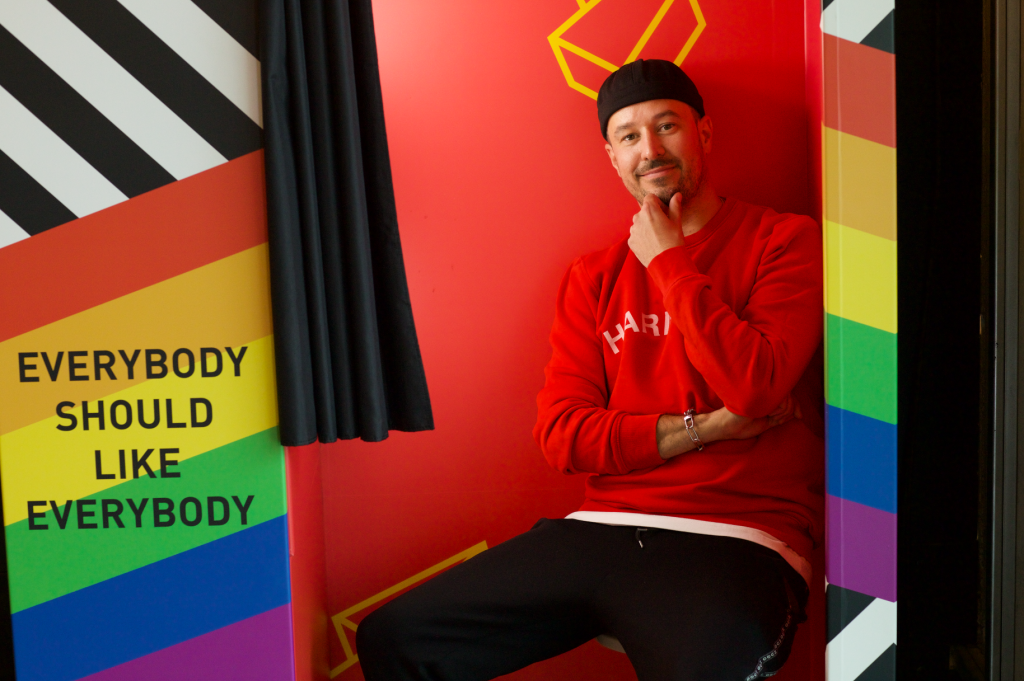Stuart Bruce Cameron (he/him)
Diversity is not a nice-to-have, but a must-have. Companies that don't understand this will be overtaken by the competition. When it comes to diversity, it's time for companies to open their eyes and hearts - and change their work culture!

I’m Stuart Bruce Cameron, 43 years old and the CEO of UHLALA Group, which I founded 14 years ago. Our main mission is to empower LGBTIQ+ people in the workplace. I am also the co-founder of PANDA with Isabel Hoyer. PANDA is a network that works to increase the presence of women in leadership positions to 50%.
Originally, I didn’t plan to work in the field of diversity. It was motivated more by a need to find a work environment where I could be open about my identity. My desire was to simply be treated the same as everyone else in the company, which was incredibly difficult 20 years ago. While organizing a career fair for the mid-market, I decided without further ado to start a fair for LGBTIQ+ friendly companies. With this, I wanted to offer other people a platform where they could see which companies were really open to diversity and actively cared about it. Then, 14 years ago, the first LGBTIQ+ career fair started, with very limited initial success: out of 3,000 companies requested, exactly 6 were willing to participate. However, these 6 companies were already pioneers at the time and even had LGBTIQ+ employee networks, which was still very rare at the time. This encouraged me that change was possible and to keep it going. Today, STICKS & STONES is one of the biggest job fairs around and we compete more with mainstream events.
In the LGBTIQ+ sector, I would immediately make it so that companies are only allowed to participate in CSD events if they are actually Pride champions. That means they must be able to demonstrate that they are actively creating LGBTIQ+ friendly work environments. Currently, all companies can participate, and often organizations even have to include companies that do little to promote the issue or even work against it. This gives the wrong impression. If CSD Germany or other associations were to introduce this criterion, the selection would be of higher quality and the message would be more authentic. This would also create clear guidelines for participation and reduce the problem of “pinkwashing”, as currently every CSD sets its own criteria.
We came at the right time when diversity was first gaining importance in Germany. The first diversity conference took place and focused on gender diversity, which is still a major topic in many companies today. Our event was the first in the career sector. Companies became aware of us because we filled a gap. As time went on, we were able to offer even more and more companies participated and dealt with the topic intensively. In addition, more LGBTIQ+ networks were formed in companies, which naturally brought the topic further forward and into the mainstream.
Unfortunately, a decisive factor why companies invest more and more in diversity is often only the economic benefit. Studies showed that the profitability of companies increases when they are diversely positioned. So that has driven even conservative companies to promote diversity to avoid losing customers and employees. Diversity work, however, is complex and requires long-term efforts. It is a misconception that it is done with small actions. It takes serious commitment from the top and more than just financial resources to achieve sustainable change.
Ein entscheidender Faktor, warum Unternehmen immer mehr in Diversität investieren, ist leider oftmals nur der wirtschaftliche Nutzen. Studien zeigten, dass die Wirtschaftlichkeit von Unternehmen steigt, wenn sie divers aufgestellt sind. Das hat also selbst konservative Unternehmen dazu bewegt, Diversität zu fördern, um Kunden und Mitarbeiter nicht zu verlieren. Diversitätsarbeit ist aber komplex und erfordert langfristige Anstrengungen. Es ist ein Missverständnis, dass es mit kleinen Aktionen getan ist. Es braucht ernsthaftes Engagement von oben und mehr als nur finanzielle Mittel, um einen nachhaltigen Wandel zu erreichen.
What moves me strongly and is currently also very present concerns the creation of an enemy image: the image of the old, heterosexual CIS man, to whom virtually everything negative in this world is attributed. This portrayal of him as a preventer of equality, opportunity, and belonging is often repeated on social media and many other platforms. This creates a distorted image that does not do justice to reality. Of course, toxic males exist, there is no question about that. But this does not apply to all of them. There are numerous men who are committed to equality, are critical of the patriarchal system, and have positive relationships with women. They are also open to the LGBTIQ+ community and fight for change.
It is essential that men are not blanketly lumped into one group, as this ultimately hurts the cause. We should be less divisive and more vocal overall. Instead of blaming a certain group, again interpreted in a very “homogeneous” way, we should rather invite everyone into the dialogue, work together on changes and improve our structures in Germany.
Especially on social media, it’s noticeable that extreme opinions often get the most attention. These extremes range from left to right, and it creates the impression of having to take a stand. For example, if someone has difficulty with gendered language, this is often immediately labeled as right-wing or sexist. Similarly, someone who respects conservative values and yet is openly LGBTIQ+ is quickly seen as “super leftist.” This polarization is exhausting and most people are probably more in the middle. The approach of using pressure to change people also usually doesn’t work sustainably. It is more effective to bring people along, allow for mistakes, and promote understanding. An inclusive approach would be desirable, one that does not aim to assign blame, but rather to work together to fight against harmful systems such as capitalism and patriarchy, which, of course, affect us all.

The most common mistake companies make is that they often invest money quickly at the beginning and then act impulsively, without planning or analysis. However, this rarely leads to success. It is usually followed by a setback in which a lot of money is wasted and little is achieved. The crucial step, in fact, is to first analyze the actual state in order to understand where the company stands in the first place. Then it requires a clear strategy for the next one to three years, followed by a detailed action plan. The process is incremental, with regular reviews of what is working and what is not. Continuous learning and adaptation can lead to steady improvement. Mistakes are inevitable, but also acceptable and a natural part of the learning process in this area. In the end, it is about a medium to long-term transformation process and not a switch that can be flipped once.
Companies must first understand that diversity management is just as important as sales, marketing and accounting. Neglect it and there is a risk of economic danger in the long term. This topic is of the utmost importance and will continue to develop and expand significantly. Therefore, it should first be examined who has led the company so far, whether attention has been paid to diversity and whether the team is heterogeneous. Of course, homogeneous groups often require significantly more persuasion. In my view, a cautious approach, communication, explanations and a step-by-step approach minimizes resistance. Hasty actions can be rather off-putting, not only for heterosexual employees, but also for LGBTIQ+ people who are not yet outed, for example. And some individuals will also reject change altogether. In some cases, it may therefore also be mutually advisable to separate in the long term.
A major mistake is to focus exclusively on gender diversity, i.e., women. Such an approach simply means introducing women instead of men without making profound changes. Often, this is limited to white, privileged, heterosexual women in the absence of a comprehensive diversity perspective. Instead, this can lead to a gender struggle in which women feel they are favored because of their gender. True diversity management looks at all dimensions, structures and processes. It ensures that the focus is on the best qualifications and skills, rather than external characteristics such as name, appearance or origin. Only a comprehensive approach is effective in the long term, even if it requires more time and resources.
The question of how to take away the fear of this is comparable to the question of whether executives are afraid to do marketing. Most understand that marketing is necessary and invest accordingly. The same understanding is needed for diversity. This perspective promotes a professional approach and effective resource allocation. In large companies, HR alone cannot suffice; sufficient human resources are necessary. Diversity should therefore be viewed like sales and marketing, professionally and in the long term. This process takes time, especially at the start, but it is essential if companies want to remain successful in the future.
The PRIDE Index is released annually at the end of December. It is a voluntary index in which companies of all sizes can participate, including public institutions. It provides a detailed assessment of LGBTIQ+ diversity. Around 200 companies participate in the audit each year. The index serves as a benchmark and shows companies’ commitment to the LGBTIQ+ field. It helps them determine their position and identify opportunities for improvement. Some companies are awarded Pride Champions, achieving particularly high scores. One notable success, for example, was McKinsey Germany, which scored 100%. However, the index only covers companies in Germany, Austria and Switzerland. Global companies often handle diversity management very differently in different countries. The results can vary greatly, depending on the location and the local corporate culture.
Something that concerns me a lot at the moment is the fact that politicians in Germany should know better how to deal with right-wing extremist tendencies. The idea of a renewed drift into a gloomy Germany worries me a lot, a development I really don’t want to see. We are also seeing an increase in violence against LGBTIQ+ people, especially those who do not perform in traditional gender roles.
Another issue that concerns me would be the introduction of a satisfaction index in Germany. After all, it’s not just about constantly monitoring the economic situation, but also recording how satisfied people actually are. If we measured and analyzed this better, we could take targeted measures to increase well-being in different regions and cities, for example. I believe that if general satisfaction were higher, far-right forces would not experience such a strong upswing. After all, in my opinion, this upswing results primarily from dissatisfaction and fear.

